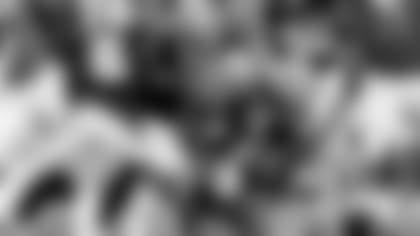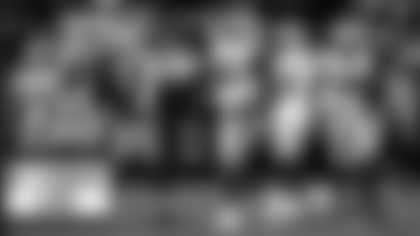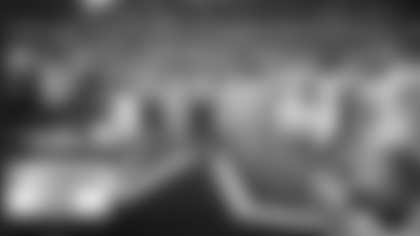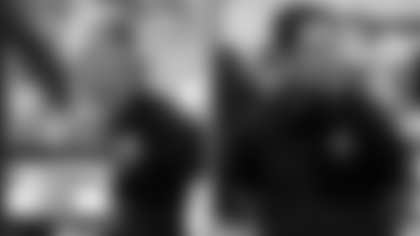Patrik [No C] Walker joined the Dallas Cowboys digital media group as a staff writer and media personality in July 2022, having professionally covered the NFL and, more specifically, the Cowboys since 2007.
He most recently did so for CBS Sports by way of 247Sports, where he also spent time delving into collegiate recruiting as well – ultimately becoming well-known for his level of unapologetic objectivity labeled by many as his own unique brand of football "science".
Welcome to "The Science Lab", a place where football facts and in-depth analysis always triumph over feelings.
FRISCO, Texas - You can paint the picture however you like, but the fact is the Dallas Cowboys aren't simply struggling against the opponent's run in 2022 - they're one of the worst in the business at it. It's no secret inside or outside of the building and, if anything, the time for becoming fully self-aware about the issue has now arrived heading into Week 11.
That's the bad news, but here's the good:
The wake-up call of all wake-up calls isn't arriving in the playoffs this time as it did when Debo Samuel dragged the Cowboys defense to the Black Lagoon in January. It's arriving immediately after the midseason bye week, and the sense of urgency to repair the issue is now at fever pitch within the building - from players to coaches to front office staff alike - with time remaining to correct the issue once and for all.
But what is the fix?
I mean, it's easy to point at a problem, but to do so without offering a solution makes it just a useless complaint and, to borrow from the late King T'Challa, we don't do that here in "The Science Lab".
Let's first begin by identifying what the Packers did well schematically on offense against the Cowboys - a three-phase set of scripted plays on their opening drive designed to not simply attack the Dallas run defense, but to get them continuously moving/looking in the wrong direction. It was almost literally as if they sanded, primed and then painted their way to a victory.
I've also attached some of my quick notes from my work charting the sequence, so that you can get a better idea of why the play worked for Green Bay and, at times, could've worked for Dallas instead.
The Sanding:
- Shovel pass left to Aaron Jones (1RB set, David Bahktiari pops outside, seals Trevon Diggs at the line of scrimmage) = 4-yard gain
- Shovel pass right to Aaron Jones (1RB set, Micah Parsons has unabated path to RB but takes inside shoulder angle that exposes the edge, missed chance at 2-yard loss) = 4-yard gain
- Shovel pass left to Aaron Jones (1RB set, Robert Tonyen seals Trevon Diggs, Leighton Vander Esch trapped in traffic, Allen Lazard commits holding on DaRon Bland (goes uncalled)) =8-yard gain (+ 15-yard unnecessary roughness penalty on Donovan Wilson)
In the first three plays from scrimmage, the Packers ran the ball, but that's not exactly breaking news that they would. What's key to note is the "who" and the "where" of the play. This is three consecutive runs to the outside edges by Jones - intentionally stretching the Cowboys defensive line laterally with the hopes of creating more interior spacing between the big boys in the middle for what the Packers are planning to do next.
And it worked.
The Primer:
- Direct handoff to A.J. Dillon (1RB set, A-gap run, Jon Runyan pulls, walls off Dorance Armstrong to create lane for RB) = 4-yard gain
- Direct handoff to A.J. Dillon (1RB set, B-gap run, Osa Odighizuwa wins matchup and grabs RB at LOS, but momentum and moving feet generate YAC) = 4-yard gain
- Direct handoff to A.J. Dillon (A-gap run, Johnathan Hankins doubled and moved further off of his spot) = 4-yard gain
- Direct handoff to A.J. Dillon (2RB set, A-gap run, Jayron Kearse crashes down naked left edge but Dillon wins first step and powers through tackle for YAC) = 5-yard gain
After burning the edges with the speedier halfback in Jones, the interior lanes were prepped for the more powerful halfback in Dillon - a formula the Cowboys themselves have often deployed when using Ezekiel Elliott and Tony Pollard. Hankins and Co. were forced to start thinking laterally to try and compensate for Jones and Dillon entered to make them pay for it, and with a near-perfect balance of reps (Jones: 3, Dillon: 4).
Having been successful in Phase 2 of the offensive plan, and in only seven plays, it was time to use the established run to set up the play action pass because, after all, Rodgers still hasn't thrown an actual pass yet - the time being now to change that as the Packers stand on the Cowboys 35-yard line.
That was about to change with the future Hall of Famer readying to throw some uppercuts at a linebacker corps and secondary that was now hellbent on stopping the run to prevent further damage.
The Paint:
- Play-action to Christian Watson on inside slant route = dropped (should've been complete for 13 yards)
- Shotgun formation, no play-action, out route to Christian Watson = dropped (should've been 1st down on 8-yard gain)
Thankfully for the Cowboys, those two drops forced Mason Crosby onto the field for a 54-yard field goal into a wall of wind that looked more like a shot pigeon that sailed right (by the way, this is another reason for the infamous fourth-down call versus asking Brett Maher to potentially suffer the same fate in overtime).
But while the bullet was dodged in the moment by the Cowboys, the Packers had already seen enough to know exactly what they needed to do to give themselves a chance at upsetting the visitors. To create their Sistine Chapel against the Cowboys, Rodgers didn't have to (nor did he want to) throw 40+ times and hope for a big day in the air.
All they had to do was run the ball but, more specifically, they ran at the edges and then built everything off of that success with chunk plays delivered by Rodgers, Watson and (in overtime) Lazard.
In the end, Rodgers threw only 20 times for only 224 yards, but with three touchdowns (all from Watson, who suddenly discovered how to not drop the ball) as the Green Bay passing attack figured out it was about quality, not quantity, against the best pass rush in the entire NFL.
And, simply put, the Cowboys absolutely, unequivocally, can not allow an unproven guy like Watson to purchase the football equivalent of Twitter Blue and appear verified for the day when he hadn't previously earned his blue NFL check mark.
All of this is key to chart and learn from because, unless that happens, the lesson will continue to repeat itself on a weekly basis en route to another disappointing finish to the season. So as the club moves on to the Minnesota Vikings and Dalvin Cook, a player who could set up Kirk Cousins in much the same way as Jones/Dillon did for Rodgers, it's all about altering either scheme and/or personnel rotations to bolster a run defense that has suddenly kneecapped its own pass rush counterpart.
Particularly with a second helping of Saquon Barkley looming in Week 12, followed by Jonathan Taylor in Week 13, another dance with the Eagles rushing attack in Week 16 and Derrick Henry (oh boy) and the Tennessee Titans in Week 17.
You get the picture, or rather the oil painting.
The Acetone:
To strip the paint from the opponent's rushing attack, for my money, it's not about adding anyone additional from free agency as much as it is striking the right balance for those already on the roster.
It's paramount the Cowboys get more from their very-capable linebacker corps as it pertains to run defense - see above for the missed angle from the otherwise intergalactic talent that is Micah Parsons and the split-second delay by Kearse on two plays that could've been tackles for loss versus two plays that averaged 4.5 gained yards.
So, at least in the aspect, it's the execution that failed, not the scheme.
If those TFLs land, the Packers possibly get spooked early and begin passing more, and making them against the Vikings will likely achieve that goal against a much more mistake-prone Kirk Cousins.
Once the linebackers effectively set the edge, the interior linemen like Hankins (who excels in a phone booth but struggles outside of it) can play downhill and not east-west. This is when you'll begin to see the interior of the defensive line excel, as RB traffic is forced their way instead of choosing the A and B gap (off-center and off-guard) because the option is now there after having been created by the faltering at the edges.
Now, back to the scheme.
That will then also allow for more reps from Hankins and Quinton Bohanna (the other very, very large human on the interior) to garner more reps, both having registered no more than 25 (39%) and 23 (36%) of defensive reps in the Week 10 loss, respectively; or it will have bottled up the opponent's run effectively enough to keep their reps below 50% to allow for the more nimble talents like Neville Gallimore and Chauncey Golston to join Osa Odighizuwa in powering up the pass rush from the interior.
Either way, it's a win-win.
As for the edge rushers, well, DeMarcus Lawrence is playing out of his mind, so let's look at his bookend on the right side, where it could be worth working a healthy Basham (8 defensive snaps, 12% against the Packers) into the rotation more against the Vikings and to award rookie fifth-round pick Sam Williams (17 defensive snap, 17%) in more as well, as Williams shows an ability to both rush the passer and seal the edge with his speed-to-power ratio; and adding Takk McKinley as an option from the practice squad inserts a lot of intrigue here for me.
If the former first-round pick can get back to top form - one that saw him rack up 16.5 sacks in his first 21 starts for the Quinn-led Falcons - while also aiding the run defense, the Cowboys will be made all the better for it.
I love what the secondary is doing schematically, e.g., using Donovan Wilson as a definitive run-stopper and guided missile, but teams are now trying to delete Trevon Diggs in run support by (see above) popping out big-body lineman to seal him off and clear a lane for the second level - meaning help is needed there and, importantly, guys have to win more at the point of attack.
And, as a related aside, the more teams can get Diggs to play run defense, the less they have to worry about him getting one or two interceptions in a game.
Lastly, circling back to the LB corps: Damone Clark.
With the injury to Anthony Barr in Week 8 against the Chicago Bears, Clark's debut ballooned unexpectedly to 40 defensive snaps and, while some showed first-year hiccups, there were flashes of what he can be as run-stopper and the guy who chases down the fastest player out of the backfield (just ask Justin Fields).
That said, Clark took the field in Week 10 for only seven defensive reps, despite Barr being absent entirely with a hamstring injury, and there's equally something to be said for continuing to ramp him up (I agree with this strategy, to a degree) but in also deciding you're tired of seeing any given halfback shred the defense.
Maybe Clark gets more reps against the Packers and the Cowboys still go on to allow 207 rushing yards, but maybe not and, at this point, every option to stop the bleeding needs to be exhausted - keeping this in mind should Barr be available against his former team and things still go awry over the course of the first half of the contest. If Barr is available, expect him healthier and emotionally juiced to take down the Vikings, the hope being he can replicate the film he created against the Los Angeles Rams (when he was all over the field).
The bottom line is teams will continue to use the Cowboys' own blood to paint an image of another promising season that possibly meets a dismal end - until further notice - not because they can't take the ball away, and not because they can't rush the passer, and not because they can't be good in coverage…
But because they can't contain running backs.
Fix that glaring issue, once and for all, and opposing teams will go full "Van Gogh", cutting their own ear off in frustration as they try to figure out if there's any other way to tame the canvas of what could otherwise be a Super Bowl-caliber defense in Dallas.
The right defensive coach is in the building (Dan Quinn) and the personnel isn't the issue either, in my opinion. It's simply an equation that needs to be solved, correctly.
And if not now, when?















